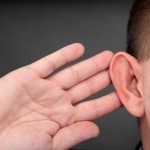
Research shows that rates of emotional and behavioural problems in deaf children are about twice as high as they are for hearing children.
Depression and anxiety are common in deaf people and they face significant barriers to accessing mental heath services according to a new review in the Lancet.
The review was carried out by a group of Austrian and American researchers, who highlight that poor communication between patients who use sign language and health professionals often means that people are unable to access psychological therapies or counselling services in primary care.
Simple tasks like arranging appointments and communicating with GPs, practice nurses and hospital staff can be problematic and so many deaf people avoid visiting the doctor as a result.
The review presents three useful checklists for health professionals, including this short summary:
How to interact with deaf patients
- Ask the patient about his or her preferred communicative approach. If it is sign language, collaborate with a signing professional or with a qualified interpreter.
- Engage the patient warmly and directly, with eye-contact as often and for as long as possible. Make it clear when focus needs to shift away, e.g. to the computer.
- Be aware of the restricted effectiveness and fatigue of lip reading. Add clear visual elements to discourse, e.g. gestures; writing notes; and use of simple, key words and grammar, drawings and many visual aids.
- When speaking, ensure that the patient has the best possible view of your face. Do not stand in front of a light source (e.g. a window or lamp).
- When speaking, use simple language and short sentences. Speak at a natural speed and volume. Give clear, concrete examples, and avoid vague, general terms and jargon.
- Avoid simultaneous comments during examination of a deaf patient. Communicate first, then act.
- Accept that good communication with deaf patients takes more time than it does with hearing patients. Plan for long patient visits because of large communication and education needs.
- Check for comprehension. Ask the patient to summarise essential points. Do not ask a patient whether he or she understood, because nodding might not mean comprehension.
The editorial that accompanies the review also discusses the fascinating work carried out by Joanna Atkinson at University College London, which focuses on the hallucinations experienced by deaf people with schizophrenia. This work highlights the possibility that deaf people with schizophrenia may not hear voices, but instead experience hallucinations such as a mental image of lips moving or hands signing. Clearly, health professionals would benefit from this knowledge and experience when seeking to diagnosis and support individuals with mental illness.
Links
Full text of the Lancet article is free, but you will have to register on the Lancet website to access it.
Dr Johannes Fellinger MD,Daniel Holzinger PhD,Robert Pollard PhD. Mental health of deaf people. The Lancet – 17 March 2012 ( Vol. 379, Issue 9820, Pages 1037-1044 ) DOI: 10.1016/S0140-6736(11)61143-4
Mental health problems twice as prevalent in deaf people. 16 Mar 2012, Action on Hearing Loss.
